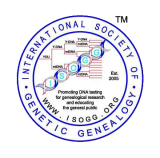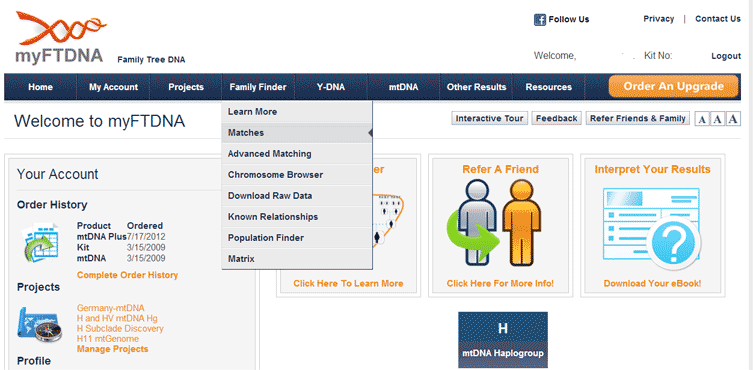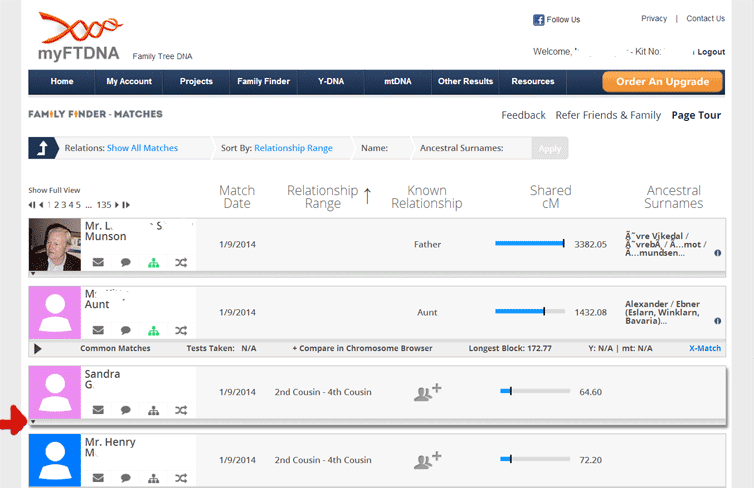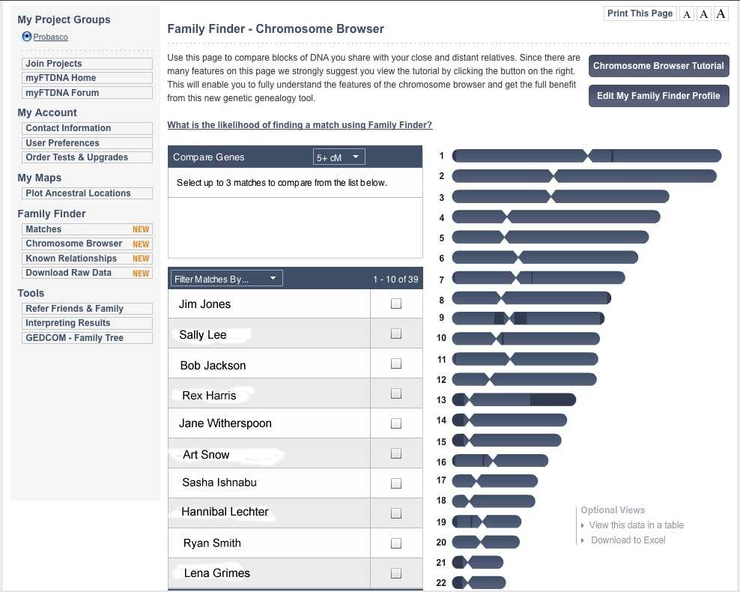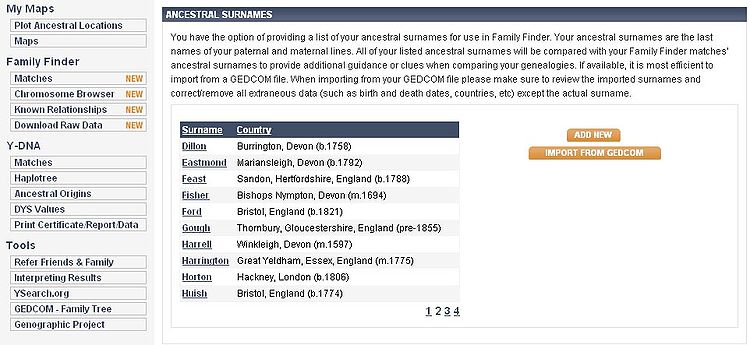Family Finder
From ISOGG Wiki
The Family Finder is an autosomal DNA test from Family Tree DNA that was first made available in February 2010.
Family Finder uses around 700,000 autosomal SNPs to help find relatives from all parts of one's family tree. Previously, DNA genealogy tests could only tell a person about a small part of their family tree based on DNA from the Y chromosome and mitochondria. By using autosomal DNA (abbreviated as atDNA), Family Finder can trace any ancestral line, no matter where it is in the family tree. The test identifies matching segments of DNA. The size and number of shared segments will help to predict the possible relationship.
To see some examples of Family Finder results for known close relationships see the screenshots in the separate article on Chromosome Browser Examples.
Steps to find your common ancestor for matches at Family Tree DNA
On your Personal Page in Family Finder, in the top bar under Family Finder, you will see the heading Matches. If you click on that it brings you to your Family Finder Matches page. You can sort your matches by the headings listed, for example Match Date to see your newest matches.
There are four useful icons under person's name. The first, an envelope, lets you email this person. The second, a dialogue icon, is for you to make notes about this person. The third, a family tree symbol, is green if they have uploaded their family tree. The last lets you choose to see all the matches in common with (or not in common with) this person.
Family Tree DNA has extensive help files. The page with help for the family finder matches page is: https://www.familytreedna.com/learn/user-guide/family-finder-myftdna/matches-page/
There is a bar with more options for each match that you get by clicking the little arrow on the bottom left of the person (our hand drawn red arrow shows where that is). The bar is extended out in the person named Aunt M in our example above.
When you receive a match in Family Finder, the first thing you must consider is the Suggested Relationship, as well as the Relationship Range. This gives you what the company feels your possible relationship is, with the Relationship Range giving you a range of where the actual relationship may be. Understand that relationships can also be outside of this range, as well, as testing autosomal DNA is not an exact science due to recombination.
Next look at the Shared cM (centimorgans) and Longest Block listed for the match. The combination of this information is what Family Tree DNA uses to determine your possible relationship. Another helpful tool on this page is the Ancestral Surnames. You can check your matches surnames to see if you may connect on a particular surname or surnames for further research.
Next view up to five of your matches in the Chromosome Browser. Do this by selecting Compare in Chromosome Browser on the bar below each person whose shared DNA segments you want to see. When you are done selecting use the big blue arrow at the top of the page to go to the chromosome browser.
You can select a single match under Filter Matches By… or up to five matches under Compare Genes. Once you make your selection(s), choose View This Data in a Table on the right side of the screen, and you will see the following information:
Example:
| Chromosome |
Start Location |
End Location |
cMs |
Matching SNPs |
| 1 |
65671560 |
67782715 |
1.94 |
503 |
| 3 |
10811712 |
14306068 |
5.22 |
607 |
| 3 |
188139229 |
189561336 |
3.2 |
503 |
| 10 |
130011574 |
132252093 |
6.01 |
583 |
| 18 |
35347234 |
38051218 |
2.02 |
503 |
| 19 |
35787466 |
46141443 |
12.94 |
1276 |
This gives you the chromosome(s) where you match; the start and end locations for that match; the total cMs for that location, and how many Single-nucleotide polymorphisms (SNPs) matched.
Features
These features can be found on your FTDNA personal page under User Preferences:
Personal Image: You have the option to insert a personal image or photo in your profile.
Ancestral Surnames: You have the option to list your Ancestral Surnames and Countries. List as many surnames from your genealogy as you can regardless of what generation they are in. Some matches have been made as far back as ten generations. List just the surname in the Surname field. Variant spellings should be listed as separate surnames. It is a good idea to list dates as well as locations in the Country field. Some people have listed the country with the state, county or province in parenthesis. Others have listed the county, province or state names first followed by the country with dates in brackets (see screenshot below). Avoid using abbreviations wherever possible. Remember that FTDNA has an international database. US state abbreviations for example will not be very familiar to your European matches.
After you have entered your ancestral surnames, you might notice that some of the ancestral surnames of your matches are highlighted in bold type, indicating that the highlighted surname might match one of yours. Note that Family Tree DNA is using a surname-matching algorithm that is somewhat liberal. For example, some pairs of surnames that it considers to be a potential match are BROWN and BRUN, NEELY and NEIL, PEGG and PIKE, and THORN and TRAHAN.
Inheritance patterns
Transfers
FTDNA accepts autosomal DNA transfers from other companies so that customers can participate in the Family Finder matching database. For details see the Learning Center article on autosomal transfers.
Family Finder reviews and user guides
- What is a Family Finder test? by Louise Coakley, Genie1 blog [10 Oct 2015; updated 2019].
- The Family Finder autosomal DNA test An overview from the Norway DNA Project
- Getting more from Family Tree DNA Family Finder by Linda Jonas, The Ultimate Family Historians, 28 December 2017.
- Family Finder review from Terry Barton 11 March 2010
- The new Family Finder test from FTDNA by Debbie Kennett 30 April 2010
- A Review of Family Tree DNA's Family Finder – Part I by Blaine Bettinger 19 July 2010
- A Review of Family Tree DNA's Family Finder – Part II by Blaine Bettinger 5 August 2010
- III - La génétique - le cas Family Tree DNA (FTDNA) - FTDNA et les outils disponibles Volet II A - Family Finder (in French) by Joss Le Gall, Le Gall de Basse Bretagne blog, 15 December 2013.
See also
- Autosomal DNA testing comparison chart
- Autosomal DNA statistics
- Autosomal DNA tools
- Raw DNA data tools
- Chromosome mapping
- Family Finder project
- Phasing
- Triangulation
External links
- FTDNA Family Finder official website
- MyFTDNA Family Finder user guide Family Tree DNA Learning Center
- Autosomal genealogy matching Family Tree DNA Learning Center
- Family Finder demo
- "Autosomal DNA: The New Revolution - Part 2" ISOGG Newsletter, Mar 2010
- FTDNA Ged to GEDCOM converter A free utility created by James Kelley which allows users to create a GEDCOM file from a tree which has been uploaded to an FTDNA personal page or which appears on an FTDNA match list. Instructions can be found here.
- Family Finder introductory video on YouTube:
